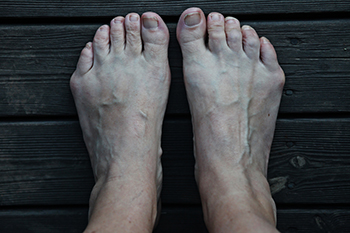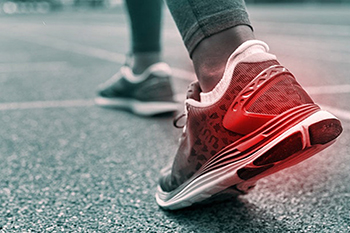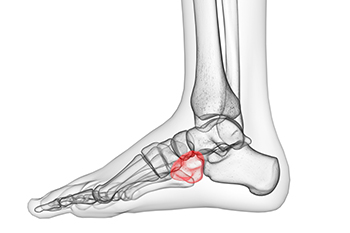Items filtered by date: October 2023
Treatment Options for Bunionettes

Tailor's bunion, also known as a bunionette, is a painful condition that develops on the outer side of the foot, specifically over the fifth metatarsophalangeal joint, or the 5th MPJ. This condition causes pressure pain, the formation of painful calluses, and difficulty when wearing shoes. One cause of tailor's bunion is a biomechanical abnormality where changes in your foot’s structure gradually cause the metatarsal bones to separate and a bunion to form. Conservative treatment options include padding, footwear modification, and custom-made orthotics. This condition is progressive and generally does not improve on its own. Surgical options include ostectomy, which removes the painful bump from the head of the fifth metatarsal. This type of surgery involves cutting the fifth metatarsal bone and realigning it. Surgical intervention may also include the removal of a painful bursa, if present. If tailor's bunion significantly hinders daily activities, causes discomfort while wearing shoes, or leads to excessive pain, it is suggested that you make an appointment with a podiatrist who can determine what the most appropriate course of action is.
If you are suffering from bunion pain, contact Ross Limon, DPM of Boca Deerfield Footcare Center. Our doctor can provide the care you need to keep you pain-free and on your feet.
What Is a Bunion?
Bunions are painful bony bumps that usually develop on the inside of the foot at the joint of the big toe. As the deformity increases over time, it may become painful to walk and wear shoes. Women are more likely to exacerbate existing bunions since they often wear tight, narrow shoes that shift their toes together. Bunion pain can be relieved by wearing wider shoes with enough room for the toes.
Causes
- Genetics – some people inherit feet that are more prone to bunion development
- Inflammatory Conditions - rheumatoid arthritis and polio may cause bunion development
Symptoms
- Redness and inflammation
- Pain and tenderness
- Callus or corns on the bump
- Restricted motion in the big toe
In order to diagnose your bunion, your podiatrist may ask about your medical history, symptoms, and general health. Your doctor might also order an x-ray to take a closer look at your feet. Nonsurgical treatment options include orthotics, padding, icing, changes in footwear, and medication. If nonsurgical treatments don’t alleviate your bunion pain, surgery may be necessary.
If you have any questions, please feel free to contact our office located in Deerfield Beach, FL . We offer the newest diagnostic and treatment technologies for all your foot care needs.
Different Types of Running Shoes

There are five main categories of running shoes that vary and fit with different running endeavors. First, there are spikes, designed for sprinting on tracks or cross-country courses. These lightweight shoes are known for their stiff plastic or metal spikes and minimal cushioning, offering superb traction for track workouts and actual racing events. Racing flats are tailored for road races and are available in a range of cushioning options, catering to different race distances. They are lighter and tend to be stiffer than training shoes, making them ideal for racing, although not for everyday training due to their minimal build. Lightweight trainers can add speed to a running routine and are good for sprints, tempo runs, and intervals because they are lightweight and flexible. Daily trainers are the workhorses of a running shoe collection. These shoes are generally moderately cushioned and built with durability in mind. They are the most comfortable choice for most types of runs, including easy runs, long runs, and recovery runs. Lastly, trail shoes are designed for off-road running, where rocks, roots, mud, and uneven surfaces can be encountered. These shoes vary widely, from lightly cushioned models resembling racing flats to bulkier options that resemble hiking boots. Their common features include enhanced tread, rock plates to protect against sharp objects, and reinforced uppers to withstand rugged terrains. If you are a runner and plan to run on different surfaces and under varied conditions, it is suggested that you make an appointment with a podiatrist. This type of doctor is able to discuss the types of running shoes to include in your assortment that can help to ensure your best comfort and performance.
If you are a runner, wearing the right running shoe is essential. For more information, contact Ross Limon, DPM from Boca Deerfield Footcare Center. Our doctor can provide the care you need to keep you pain-free and on your feet.
Choosing the Right Running Shoe for Your Foot Type
To increase performance and avoid the risk of injury, it is important to choose the right running shoe based on your foot type. The general design of running shoes revolves around pronation, which is how the ankle rolls from outside to inside when the foot strikes the ground.
- Neutral runners are able to choose from a wide variety of shoes, including minimalist shoes or even going barefoot.
- Runners who overpronate, or experience an over-abundance of ankle rolling, should choose shoes that provide extra motion control and stability.
- Runners who underpronate, or supinate, have feet that have high arches and lack flexibility, preventing shock absorption. They require shoes with more flexibility and cushion.
If you have any questions please feel free to contact our office located in Deerfield Beach, FL . We offer the newest diagnostic and treatment technologies for all your foot and ankle needs.
Weight and Foot Problems

Many people are considered to be overweight or obese, which can negatively impact the feet in various ways. Carrying excess weight increases the load on the feet during weight bearing activities, and can lead to pain and injuries that discourage physical activity. Additionally, obesity may raise the risk of chronic diseases such as diabetes, which can harm peripheral circulation and nerve supply in the feet. This issue is not limited to adults. Childhood obesity is a growing concern, with structural and functional changes in the feet that can affect a child's current well being and may persist into adulthood. Common foot complaints related to increased weight include non specific foot pain, tendonitis, plantar fasciitis, and osteoarthritis. It is important to remember that obesity is a complex issue with various contributing factors, including genetics, lifestyle, and environmental influences. Blaming or stigmatizing individuals for their weight can be counterproductive and harmful. Instead, offering support, encouragement, and resources for maintaining a healthy lifestyle can be more effective in addressing both obesity and its related health concerns, including foot problems. If you are overweight and are experiencing foot consequences, it is suggested that you make an appointment with a compassionate podiatrist who can provide you with help in living a healthier lifestyle and relieving your foot pain.
Obesity has become very problematic at this point in time and can have extremely negative effects on the feet. If you’re an obese individual and are concerned about your feet, contact Ross Limon, DPM from Boca Deerfield Footcare Center. Our doctor can provide the care you need to keep you pain-free and on your feet.
Obesity and Your Feet
Since your feet are what support your entire weight when standing, any additional weight can result in pain and swelling. Being overweight is one of the main contributors to foot complications.
Problems & Complications
Extra Weight – Even putting on just a few extra pounds could create serious complications for your feet. As your weight increases, your balance and body will shift, creating new stresses on your feet. This uneven weight distribution can cause pain, even while doing the simplest tasks, such as walking.
Diabetes – People who are overweight are at serious risk of developing type-2 diabetes, which has a drastic impact on the health of your feet. As you get older, your diabetes might worsen, which could lead to loss of feeling in your feet, sores, and bruises. You could also become more prone to various infections.
Plantar fasciitis – Pressure and stress that is placed on muscles, joints, and tendons can trigger plantar fasciitis, which is an inflammation of tissue that forms along the bottom of the foot.
If you have any questions please feel free to contact our office located in Deerfield Beach, FL . We offer the newest diagnostic and treatment technologies for all your foot and ankle needs.
Keep Your Feet Healthy So You Can Stay Active
Fall Proof Your Home to Create a Safe Haven

As you age, ensuring your home is safe becomes increasingly important to prevent falls and injuries. Fall proofing your living space can significantly reduce the risk of accidents. This can begin by decluttering walkways and removing any potential tripping hazards, such as loose rugs or cords. Installing grab bars in bathrooms and railings on stairs can help to provide support. Adequate lighting throughout your home is essential, and well lit areas can help you see potential obstacles more clearly. Keep frequently used items within easy reach to prevent unnecessary stretching or bending. Consider non-slip mats in the bathroom and kitchen to avoid slipping on wet surfaces. Regularly inspect and maintain the condition of your floors, ensuring they are even and free of loose tiles or floorboards. If you would like to learn about how fall prevention techniques can protect the feet, it is suggested that you consult a podiatrist.
Preventing falls among the elderly is very important. If you are older and have fallen or fear that you are prone to falling, consult with Ross Limon, DPM from Boca Deerfield Footcare Center. Our doctor will assess your condition and provide you with quality advice and care.
Every 11 seconds, an elderly American is being treated in an emergency room for a fall related injury. Falls are the leading cause of head and hip injuries for those 65 and older. Due to decreases in strength, balance, senses, and lack of awareness, elderly persons are very susceptible to falling. Thankfully, there are a number of things older persons can do to prevent falls.
How to Prevent Falls
Some effective methods that older persons can do to prevent falls include:
- Enrolling in strength and balance exercise program to increase balance and strength
- Periodically having your sight and hearing checked
- Discuss any medications you have with a doctor to see if it increases the risk of falling
- Clearing the house of falling hazards and installing devices like grab bars and railings
- Utilizing a walker or cane
- Wearing shoes that provide good support and cushioning
- Talking to family members about falling and increasing awareness
Falling can be a traumatic and embarrassing experience for elderly persons; this can make them less willing to leave the house, and less willing to talk to someone about their fears of falling. Doing such things, however, will increase the likelihood of tripping or losing one’s balance. Knowing the causes of falling and how to prevent them is the best way to mitigate the risk of serious injury.
If you have any questions, please feel free to contact our office located in Deerfield Beach, FL . We offer the newest diagnostic and treatment technologies for all your foot care needs.
Common Symptoms and Causes of Cuboid Syndrome

Cuboid syndrome, though relatively rare, is a painful condition that affects the cuboid bone in the foot. Understanding its causes and recognizing the symptoms is crucial for timely diagnosis and effective treatment. One of the primary causes of cuboid syndrome is an injury or trauma to the foot, such as a sudden twist or strain. This can dislocate, or subluxate, the cuboid bone, leading to pain and discomfort. Athletes, especially those involved in activities requiring repetitive foot movements, are more prone to this condition. The noticeable symptom of cuboid syndrome is pain on the lateral side of the foot, typically around the midfoot area. This pain can be sharp, stabbing, or aching, and it often worsens with weight-bearing activities like walking or running. You may also experience swelling and limited range of motion in the affected foot. Treatment options may include rest and taping, in addition to realigning the cuboid bone. Early intervention can help alleviate symptoms and prevent long-term issues. If you have pain on the outside of your foot, it is suggested that you visit a podiatrist who can accurately diagnose and treat cuboid syndrome.
Cuboid syndrome, also known as cuboid subluxation, occurs when the joints and ligaments near the cuboid bone in the foot become torn. If you have cuboid syndrome, consult with Ross Limon, DPM from Boca Deerfield Footcare Center. Our doctor will assess your condition and provide you with quality foot and ankle treatment.
Cuboid syndrome is a common cause of lateral foot pain, which is pain on the outside of the foot. The condition may happen suddenly due to an ankle sprain, or it may develop slowly overtime from repetitive tension through the bone and surrounding structures.
Causes
The most common causes of cuboid syndrome include:
- Injury – The most common cause of this ailment is an ankle sprain.
- Repetitive Strain – Tension placed through the peroneus longus muscle from repetitive activities such as jumping and running may cause excessive traction on the bone causing it to sublux.
- Altered Foot Biomechanics – Most people suffering from cuboid subluxation have flat feet.
Symptoms
A common symptom of cuboid syndrome is pain along the outside of the foot which can be felt in the ankle and toes. This pain may create walking difficulties and may cause those with the condition to walk with a limp.
Diagnosis
Diagnosis of cuboid syndrome is often difficult, and it is often misdiagnosed. X-rays, MRIs and CT scans often fail to properly show the cuboid subluxation. Although there isn’t a specific test used to diagnose cuboid syndrome, your podiatrist will usually check if pain is felt while pressing firmly on the cuboid bone of your foot.
Treatment
Just as the range of causes varies widely, so do treatments. Some more common treatments are ice therapy, rest, exercise, taping, and orthotics.
If you have any questions, please feel free to contact our office located in Deerfield Beach, FL . We offer the newest diagnostic and treatment technologies for all your foot care needs.




